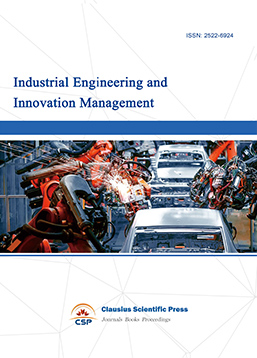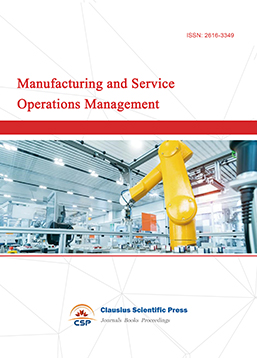Choosing the Right Partner or Controlling the Partner Right? Partner Selection, Control and Radical Innovation
DOI: 10.23977/ferm.2019.21002 | Downloads: 34 | Views: 2813
Author(s)
Wenxia Yang 1
Affiliation(s)
1 School of Management, Shanghai University, Shanghai 200444, China
Corresponding Author
Wenxia YangABSTRACT
Partner selection and partner control are two important mechanisms to solve the potential control problems in inter-organizational innovation cooperation. However, few existing literatures comprehensively evaluate the impact of the two control mechanisms on enterprise innovation. Based on the theory of management control, the research constructs a joint effect model of partner selection and partner control that influences enterprise radical innovation, and examines the impact of partner selection and partner control on enterprise radical innovation and its internal mechanisms. The result shows that: (1) partner selection has no direct impact on enterprise radical innovation, but it has an indirect impact on enterprise radical innovation through partner control; (2) partner control can directly and indirectly affect enterprise radical innovation through partial mediation of strategic information sharing, and the direct effect of outcome control on enterprise radical innovation is more significant, the indirect effect of behavior control on enterprise radical innovation is more significant through inter-organizational strategic information sharing; (3) partner selection has an indirect impact on enterprise radical innovation through partner control and strategic information sharing, partner control and strategic information sharing play a role as a chain intermediary in the relationship between partner selection and enterprise radical innovation. The conclusion reveals that it is important to choose the right partner in the innovation cooperation, but it is more important to control the partner right. Only by exerting reasonable control over the partner can partner selection give full play to its value.
KEYWORDS
Partner selection, partner control, strategic information sharing, radical innovationCITE THIS PAPER
Wenxia Yang, Choosing the Right Partner or Controlling the Partner Right? Partner Selection, Control and Radical Innovation. Financial Engineering and Risk Management (2019) 2: 7-23. DOI: http://dx.doi.org/10.23977/ferm.2019.21002.
REFERENCES
[1] Jiang J F, Li X B, Yin T T, et al. Formation of Breakthrough Technology Innovation: Review and Outlook [J]. R&D Management, 2017, 29 (6): 109-120.
[2] Kelley D. Adaptation and organizational connectedness in corporate radical innovation programs [J]. Journal of Product Innovation Management, 2009, 26 (5): 487–501.
[3] Dekker H C, Ding R, Groot T. Collaborative performance management in interfirm relationships [J]. Journal of Management Accounting Research, 2016, 28 (3): 25-48.
[4] Dai L, Zhi X Q. Could Firms Learning Process and Outcome Based on Inter-firm Cooperation be Effectively Evaluated? The Approach of Performance Evaluation Theory [J]. Accounting Research, 2015 (12): 45-52.
[5] Anderson S, Christ M, Dekker H, et al. The use of management controls to mitigate risk in strategic alliances: field and survey evidence [J]. Journal of Management Accounting Research, 2014, 26 (1): 1-32.
[6] Crosno J L, Brown J R. A meta-analytic review of the effects of organizational control in marketing exchange relationships [J]. Journal of the Academy of Marketing Science, 2015, 43 (3): 297-314.
[7] Hao B, Li J L, Vincent F. Analysis of the Latest Development if Inter-firm Relationship Partner Selection [J]. Foreign Economics & Management, 2014, 36 (1): 55-64.
[8] Luo Y, Liu Y, Zhang L, et al. A taxonomy of control mechanisms and effects on channel cooperation in China [J]. Journal of the Academy of Marketing Science, 2011, 39 (2): 307-326.
[9] Pernot E, Roodhooft F. The impact of inter-organizational management control systems on performance: a retrospective case study of an automotive supplier relationship [J]. International Journal of Production Economics, 2014, 158: 156-170.
[10] Yuan L, Xie E, Teo H H, et al. Formal control and social control in domestic and international buyer–supplier relationships [J]. Journal of Operations Management, 2010, 28 (4): 333-344.
[11] Bedford D S. Management control systems across different modes of innovation: implications for firm performance [J]. Management Accounting Research, 2015, 28: 12-30.
[12] Wang L W, Li X D. An empirical study of the impact of alliance control on firm’s radical innovation [J]. Studies in Science of Science, 2015, 33 (5): 792-800.
[13] You D M, Huang X Z. Partner Selection and Evaluation of Radical Technological Innovation [J]. Systems Engineering, 2014, 32 (3): 99-103.
[14] Carson S J. When to give up control of outsourced new product development [J]. Journal of Marketing, 2007, 71 (1): 49-66.
[15] Liu X M, Li Y, Feng J L. Influence Analysis on Enterprise’s Internal Control Mechanism Related to the Choice of Innovation Mode [J]. Nankai Business Review, 2006 (02): 64-68+83.
[16] Mahama H. Management control systems, cooperation and performance in strategic supply relationships: a survey in the mines [J]. Management Accounting Research, 2006, 17 (3): 315-339.
[17] Yu J T, Hu C H. Study on partner selection of synergy innovation in technology alliance [J]. Scientific Management Research, 2015, 33 (1): 13-16.
[18] Blumberg, Boris F. Efficient partner search: embedded firms seeking cooperative partners [J]. Journal of Mathematical Sociology, 2001, 25 (4): 329-354.
[19] Deng Y. Market or Relationship Dependency? The Effect of Alliance Partner Selection Orientation on Technology Innovation [J]. Foreign Economics & Management, 2016, 38 (5): 15-31.
[20] Das T K, Teng B S. Trust, control, and risk in strategic alliances: an integrated framework [J]. Organization Studies, 2001, 22 (2): 251-283.
[21] Dekker H C. Control of inter-organizational relationships: evidence on appropriation concerns and coordination requirements [J]. Accounting Organizations & Society, 2004, 29 (1): 27-49.
[22] Zhang Q, Zhou K Z. Governing interfirm knowledge transfer in the Chinese market: The interplay of formal and informal mechanisms [J]. Industrial Marketing Management, 2013, 42 (5): 783-791.
[23] Ritala P, Hurmelinna-Laukkanen P. Incremental and radical innovation in coopetition—the role of absorptive capacity and appropriability [J]. Journal of Product Innovation Management, 2013, 30 (1): 154-169.
[24] Liu J D, Dang X H. Research on the Relationship of Knowledge Acquisition Modes and Radical Innovation under Different Levels of Knowledge Potential [J]. Management Review, 2013, 25 (7): 88-98.
[25] Wang Y J, Xie W H, Wang T H, et al. Research on the Relationship between Strong/Weak Ties and Radical Innovation: The Mediating Effect of Absorptive Capacity and Moderating Effect of Environmental Dynamism [J]. Management Review, 2016, 28 (10): 111-122.
[26] Dekker H C. Partner selection and governance design in interfirm relationships [J]. Accounting Organizations & Society, 2008, 33 (7–8): 915-941.
[27] Ding R, Dekker H C, Groot T. Risk, partner selection and contractual control in interfirm relationships [J]. Management Accounting Research, 2013, 24 (2): 140-155.
[28] Yang H J, Yang J J. Research on the Impact of External Search, Linking Intensity and Absorptive Capacity on Innovation Performance [J]. Journal of Management Science, 2016, 29 (3): 24-37.
[29] Zhang F, Liu X. Study on the Influencing Mechanism of External Knowledge Search on Innovation Performance [J]. Journal of Management Science, 2014, 27 (1): 31-42.
[30] Song J, Chen J H, Sun Y L. Impact of Network Search on Cooperative Innovation Performance in Different Regional Culture [J]. Journal of Management Science, 2014, 27 (3): 39-49.
[31] Turner K L, Makhija M V. The role of organizational controls in managing knowledge [J]. Academy of Management Review, 2006, 31 (1): 197-217.
[32] Ireland R D, Hittm A, Vaidyanath D. Alliance management as a source of competitive advantage [J]. Journal of Management, 2002, 28 (3): 413-446.
[33] Dekker H C, Abbeele A V D. Organizational learning and interfirm control: the effects of partner search and prior exchange experiences [J]. Organization Science, 2010, 21 (6): 1233-1250.
[34] Lavie D, Khanna P. Organizational differences, relational mechanisms, and alliance performance [J]. Strategic Management Journal, 2012, 33 (13): 1453–1479.
[35] Davila A, Foster G, Li M. Reasons for management control systems adoption: insights from product development systems choice by early-stage entrepreneurial companies [J]. Accounting Organizations & Society, 2009, 34(3-4): 322-347.
[36] Geng Z Z, Liu X M, Yang C H. The Effect of Strategic Orientations and External Knowledge Acquisition on Organizational Creativity[J]. Nankai Business Review, 2012, 15(4): 15-27.
[37] Li B Z, Gao S. Reciprocity, Knowledge Sharing and Collaborative Original Innovation[J]. R&D Management, 2017, 29(3): 76-86.
[38] Kang K H, Kang J. How do firms source external knowledge for innovation? Analysing effects of different knowledge sourcing methods [J]. International Journal of Innovation Management, 2009, 13 (1): 1-17.
[39] Zhang J, Xu Q R, Zhang S P. The impact of knowledge management on a firm’s innovation capability in adynamic environment [J]. Science Research Management, 2014, 35 (4): 59-67.
[40] Joshi A W. Continuous supplier performance improvement: effects of collaborative communication and control[J]. Journal of Marketing, 2009, 73 (1): 133-150.
[41] Heide J B, Wathne K H, Rokkan A I. Interfirm monitoring, social contracts, and relationship outcomes[J]. Journal of Marketing Research, 2007, 44 (3): 425-433.
[42] Li J, Sikora R, Shaw M J, et al. A strategic analysis of inter organizational information sharing[J]. Decision Support Systems, 2006, 42 (1): 251-266.
[43] Choe J M. Inter-organizational relationships and the flow of information through value chains[J]. Information & Management, 2008, 45(7): 444-450.
[44] Sun Y F, Li Y, Liao X W. A Study of Corporate Innovation and Internal Controls under Heterogeneous Strategic Orientations [J]. Journal of Industrial Engineering and Engineering Management, 2007, 21 (4): 24-30.
| Downloads: | 15862 |
|---|---|
| Visits: | 330046 |
Sponsors, Associates, and Links
-
Information Systems and Economics

-
Accounting, Auditing and Finance

-
Industrial Engineering and Innovation Management

-
Tourism Management and Technology Economy

-
Journal of Computational and Financial Econometrics

-
Accounting and Corporate Management

-
Social Security and Administration Management

-
Population, Resources & Environmental Economics

-
Statistics & Quantitative Economics

-
Agricultural & Forestry Economics and Management

-
Social Medicine and Health Management

-
Land Resource Management

-
Information, Library and Archival Science

-
Journal of Human Resource Development

-
Manufacturing and Service Operations Management

-
Operational Research and Cybernetics


 Download as PDF
Download as PDF